#Four-banded Stink Bug Wasp
Text

Four-banded Stink Bug Wasp
After capturing and paralyzing this stink bug, the Four-banded Stink Bug Wasp carried it to a sandy place where it buried the bug while attaching its egg, which after hatching, fed on the immobile insect. Every living thing has its own individual story to tell.
9 notes
·
View notes
Text
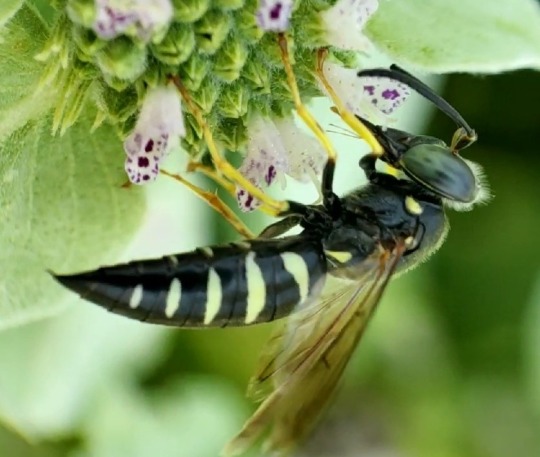
Four-banded stink bug wasp (Bicyrtes quadrifasciatus), a type of sand wasp, in central Pennsylvania.
Sand wasps are called that because they like to lay their eggs in burrows they dig in sand. The female of this species hunts for hemiptera (true bug) nymphs, mainly stink bugs, which she stings and paralyzes. She carries the still living nymphs back to the nest where she lays her eggs. After it is well-stocked with victims, she seals it off. Her larvae will eat the paralyzed nymphs when they hatch.
The adults eat nectar and are pollinators. They can also help with invasive species control, assuming it's a species their larvae would find appetizing.
Here’s another one I found nearby digging a nest:
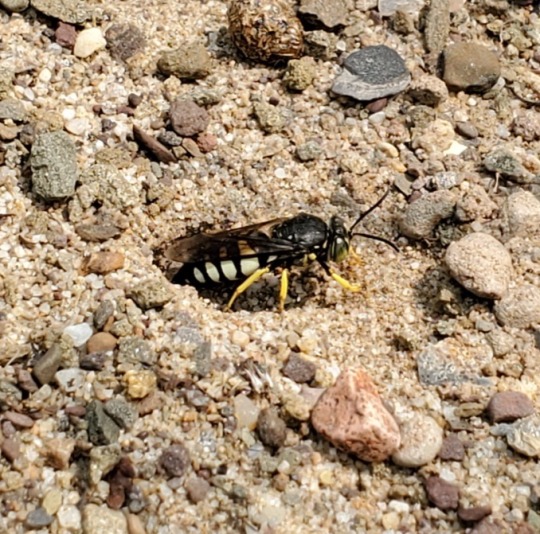
#wasp#wasps are cool#stink bug wasp#Bicyrtes quadrifasciatus#sand wasp#Penn State arboretum#four-banded stink bug wasp#buzz buzz#hymeoptera#Pennsylvania#nature#bugs#nature photography#biodiversity#animals#inaturalist#arthropods#bugblr#insect appreciation#entomology#wasp appreciation#no wasp hate here please#pollinators#support native pollinators#invertebrates#insects#interesting facts#science#fun facts#biology
21 notes
·
View notes
Text

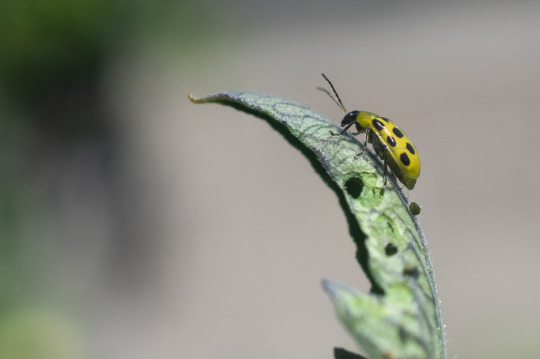

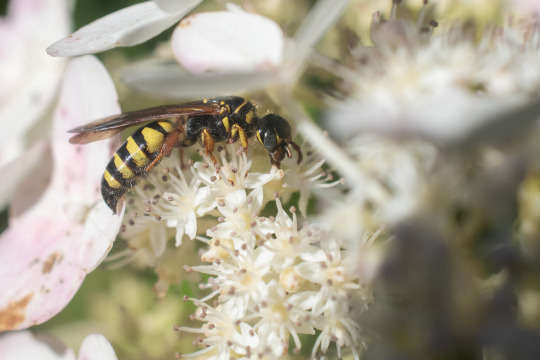
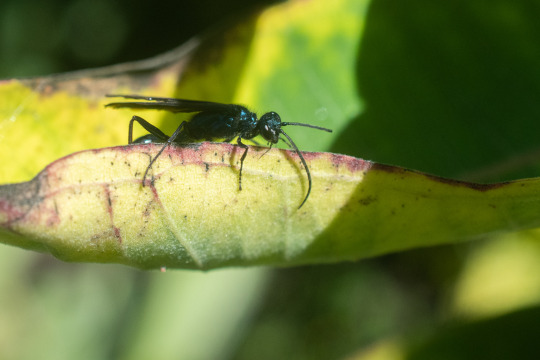


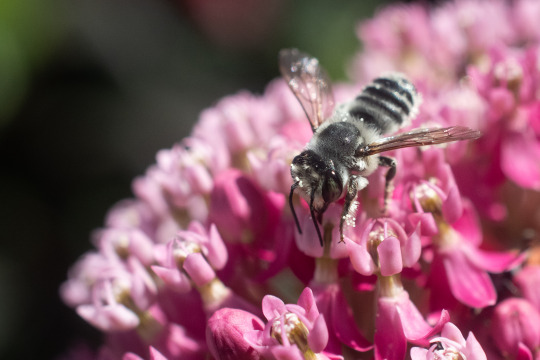





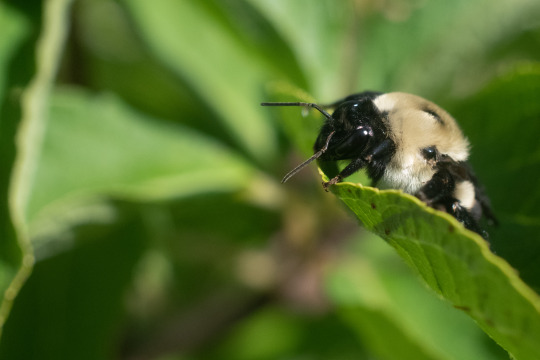
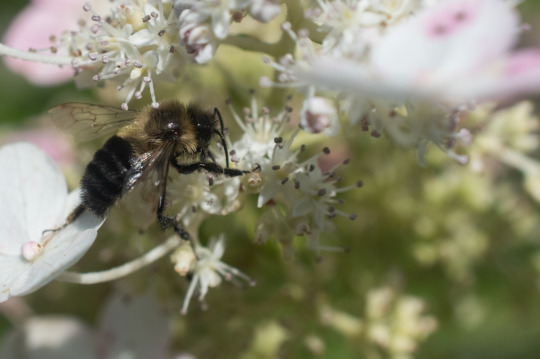
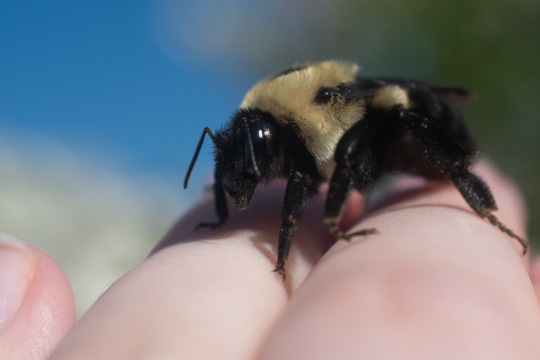


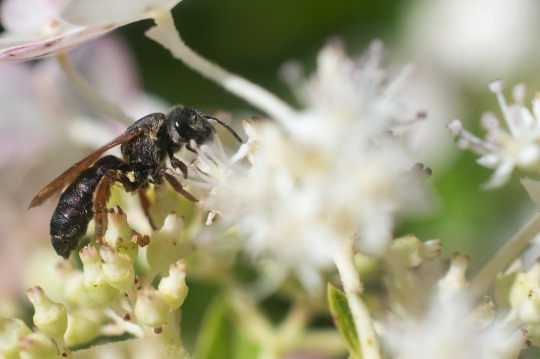

European Paper Wasp (Polistes dominula) ♂
Spotted Cucumber Beetle (Diabrotica undecimpunctata)
Great Golden Digger Wasp (Sphex ichneumoneus)
Five-banded Thynnid Wasp (Myzinum quinquecinctum)
Common Blue Mud-dauber Wasp (Chalybion californicum)
Chrysidini sp.
Four-banded Stink Bug Wasp (Bicyrtes quadrifasciatus)
Megachile sp.
Parallel-striped Sweat Bee (Halictus parallelus)
Myzinum maculatum ♀
Archytas apicifer?
Goldenrod Soldier Beetle (Chauliognathus pensylvanicus)
Archytas apicifer?
Common Eastern Bumble Bee (Bombus impatiens) ♀
Common Eastern Bumble Bee (Bombus impatiens) ♂
Common Eastern Bumble Bee (Bombus impatiens) ♀
Lobed Mason Wasp (Ancistrocerus antilope)
Narrow-headed Marsh Fly (Helophilus fasciatus)
Hawthorn Mining Bee (Andrena crataegi)?
Vespula Sp.
Foaming at the mouth at the absolute biodiversity in my yard this year! We have this bush in the yard that the wasps, bees and flies are obsessed with, which is where I took most of the pictures.
I also noticed these HUGE flies which I've never seen before. Usually if you even look in the general direction of a fly it immediately takes off but these ones could not care less, I could put my hand right up to them and they didn't move until I physically touched them.
Also once again completely baffled by the people who talk about how "aggressive" and "mean" wasps are and how they constantly get stung. What are you guys doing??? None of the above species gave a single shit about me shoving my macro lens in their faces, and if it was windy I would sometimes grab the branch they were on to hold it steady and none of them even reacted.
The queen bee (which has a stinger unlike the males) also made no effort to sting me, after picking her up for a photo she actually refused to get off of my hand because she wanted to sit on me and groom her face.
We've also had lots of yellowjackets (I'm so bad at IDing them so no idea on species) approaching us recently and checking us out, flying extremely close and looking at us and then flying away. Even if I put my hand up in front of them to see if they want to land they sort of just look at it and then fly away.
Last year there were paper wasps on nests in my yard and they would stare at me warily but never sting me when I photographed them.
Also feel free to ID things on my iNaturalist or correct me on any IDs here!
#Long Post#Not Pets#Wildlife Photography#Invertebrates#European Paper Wasp#Spotted Cucumber Beetle#Great Golden Digger Wasp#Five-banded Thynnid Wasp#Common Blue Mud-dauber Wasp#Four-banded Stink Bug Wasp#Parallel-striped Sweat Bee#Goldenrod Soldier Beetle#Common Eastern Bumble Bee#Lobed Mason Wasp#Narrow-headed Marsh Fly#Hawthorn Mining Bee#Yellowjacket
1 note
·
View note
Text


couple pics of a four-banded stinkbug hunter that could be better. these babies move fast, burrow in sand, and as the name suggests, their main diet comprises of brown marmorated stink bugs.
#wasp#insect#four banded stinkbug hunter#mountain mint#clustered mountain mint#in awe#bug#stink bug hunter#ive got pictures on my mind
2 notes
·
View notes
Text



*points* a baby
2 notes
·
View notes
Text




four-banded stink bug hunter wasp, Bicyrtes quadrifasciatus
6 notes
·
View notes
Photo



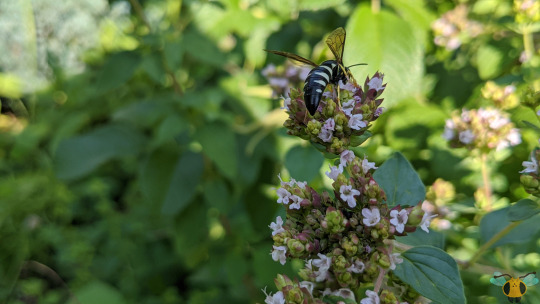

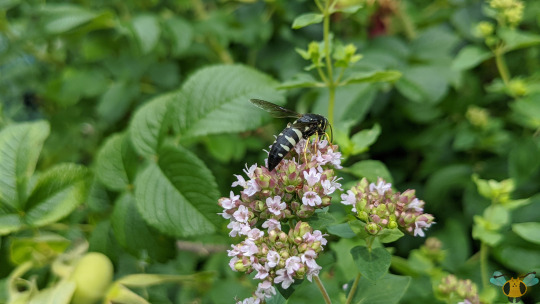

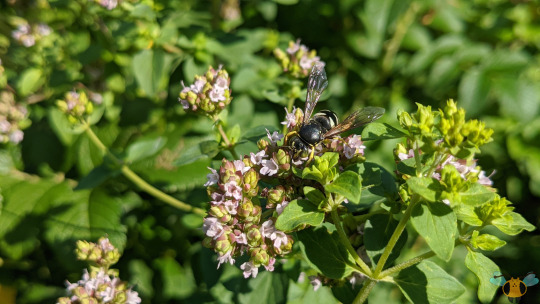
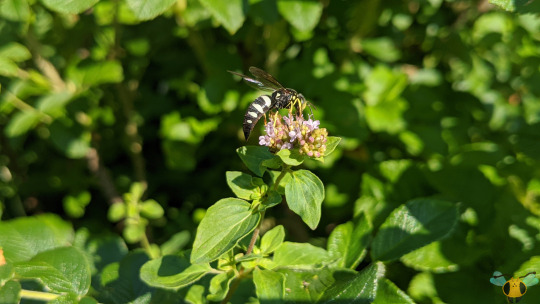
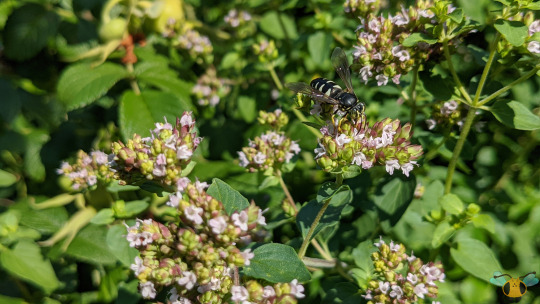
Four-Banded Stinkbug Wasp - Bicyrtes quadrifasciatus
Firstly, this Wasp now has a common name! When first posting about this insect years ago it didn’t have one, so I named it here as the “Four-Banded Black Sand Wasp” to make finding it easy. The name was a reference to its characteristic quad-striping on the abdomen, its classification as a Sand Wasp (of the Tribe Bembicini), with a “black sand” mention for added coolness since black sand is simply amazing. With a common name now given to this striped flower prowler, posts and tags have been changed to reflect the new name: Four-Banded Stinkbug Wasp. I’ve also seen it named as the Stink Bug Hunter Wasp, which clearly explains what exactly it does the Stinks Bugs that it finds, more on that below. Secondly, also mentioned in the previous post was that these insects likely found the oregano in the yard by chance and possibly burrow elsewhere due to activity from established Digger Wasps in the yard. Well, as the years have gone forward, they’ve returned every summer to inspect the oregano flowers for food. Whether or not these Wasps are establishing home in the yard remains to be seen, but looks like the descendants of the Wasps can find the oregano bushes quite easily. Hopefully these pictures give a better view on the features of this Wasp, especially with regards to the Wasp’s head.
They’re genuinely not fond of looking directly at the camera, which is a shame given their large eyes (a necessity when hunting flying prey). Using those eyes, the females find Stink Bug nymphs, sting them and haul them to their burrow as provision for their young. As confirmed from pictures other bug hunters have taken of these insects, the prey items they carry tend to wide, which may task the Wasp of widening the entrance to its burrow in order to pull the prey underground. I imagine that must be the case with the Brown Marmorated Stink Bug! While Stink Bugs are considered their primary prey, I wonder how frequently similar looking insects are captured are prey as well (there’s talk of the Conifer Seed Bug, which is mistaken often for a Stink Bug since it too emits odor as a defense). Getting back to observations, all you’re likely to see immediately are the four bands that decorate the abdomen. If you’re sharp eyed while viewing these pictures, you’ll notice that the bands grow thinner and farther apart from connecting to the “spine” of the abdomen as you move closer to the tip of the abdomen. This examination means you’ve successfully identified B. quadrifasciatus! On occasion, males have been found with their elongated abdomens featuring 5 stripes! If you can positively identify your Wasp, knowing its a male means there’s no fear of being stung from the 5-striped specimen. It has to have defined bands though; a speck of color does not count!
Pictures were taken on July 12 and 21, 2020 with a Google Pixel 4.
#jonny’s insect catalogue#ontario insect#wasp#four banded stinkbug wasp#sand wasp#hymenoptera#insect#2020#july2020#toronto#entomology#nature#invertebrates#arthropods
10 notes
·
View notes
Text



four-banded stink bug wasp AKA stink bug hunter (Bicyrtes quadrifasciatus). The females bring true bugs such as stinkbugs to their burrows to feed their young.
#g postin#insects#bugs#wasps#hymenoptera#sand wasps#four-banded stink bug wasp#four-banded stink bug hunter
1 note
·
View note
Photo

Four-banded Stink Bug Wasp (Bicyrtes quadrifasciatus)
July 31, 2021
Southeastern Pennsylvania
#bug#bugs#photographers on tumblr#Bicyrtes quadrifasciatus#four banded stink bug wasp#wasps#hymenoptera#sand wasps#insect#insects#entomology
426 notes
·
View notes
Text
!!! i got bored and decided to make a list of all the wild bugs/arthropods ive ever seen with my own eyes and been able to identify annnnd here it is! i’m up to 85 and imma go through old pics to find more bc i KNOW there are more.
White tailed skimmer dragonfly
Widow skimmer dragonfly
Red saddlebags dragonfly
Double banded scoliid wasp
European yellowjacket wasp
Four toothed mason wasp
American bumblebee
Eastern bumblebee
European Honeybee*
Carpenter bee
European hornet*
Eastern yellowjacket
European paper wasp*
Eastern paper wasp
Red paper wasp
Common paper wasp
Cicada killer wasp
Spider wasp
17 year cicada
Metallic green sweat bee
Anormenis chloris leafhopper
Common meadow katydid
Fork-tailed bush katydid
Black and yellow mud dauber wasp
Marbled orb weaver spider
Silver spotted skipper butterfly
Snowy urola moth
Wavy lined emerald moth caterpillar
Common buckeye butterfly
Monarch butterfly
Tiger swallowtail
Black swallowtail
Zebra swallowtail
Red spotted purple butterfly
Red admiral butterfly
Fiery skipper butterfly
Cabbage white butterfly
Hummingbird hawkmoth
Pandora sphinx moth
Bald faced hornet
Wheel bug
Leaf footed bug
Eastern firefly
Marmorated stink bug*
Carolina mantis
Chinese mantis*
Periodical cicada
Common looper moth
Velvet ant wasp
Army worm caterpillar
Eastern tent caterpillar
Eastern tent moth
Wheel bug nymph
ladybug
Box elder bug
Wood louse
Pill millipede
House centipede
Peck’s skipper butterfly
Black widow spider
Robber fly
Crane fly
Dogbane leaf beetle
Earwig (idek wtf an earwig actually is. Is it a beetle?? Is it in the termite family?? Who are you, earwig? Imma look it up. Ok i just looked it up and MOTHER OF GOD they’re in the COCKROACH family and i will explain in the post after this one why i find that to be HORRIBLE news for me)
Japanese beetle*
Cucumber beetle
Northern walkingstick
Cabbage worm
European chafer beetle (I HATE!!!)*
Polyphemus moth
Luna moth
Dobsonfly
Silverfish
American cockroach
Oriental cockroach
German cockroach
Wolf spider
Nursery web spider
Crowned orb weaver
Garden spider
Funnel web spider
(eastern?) harvestman
White spotted jumping spider
American green crab spider
Florida lubber grasshopper
1 note
·
View note
Note
hey, some follow up on my thyanta perditor eggs, how long does it usually take stinkbugs to hatch? you are able too see them, right? is there anything that could make them not hatch or be delayed? i read that they take about 6 days but im nearing on 10 days and getting nervous about the babies. thank you! :)
Hatch time can be highly dependent on temperature and other environmental cues (length of day maybe?). Warmer climates have faster hatch times and faster development because metabolism also speeds up with increasing temperature.
For my Thyantas, the brown stripes just got darker (or lighter? I think I posted them on here with my stink babies tag), I didn’t notice their faces BUT I also didn’t know to look for them.
Also, I have seen faces show up, and the eggs never hatched… then… wasps came out. If there is an egg, there is a wasp that parasitizes it. And the wasps develop completely to adulthood in their host, so they take longer to come out that the babies normally would.
Best strategy to adopt for any eggs you collect: hold them in a container nothing can climb out of (paper towel rubber banded over jar, or a sealed plastic container which you open a crack once a day to refresh the air and prevent mold). This way, babies can’t escape, and you don’t end up with a ton of weird random tiny flies (psst: they’re wasps!!) in your home.
Posted July 24, 2018, from Calgary, after not sleeping more than four hours in three days because hey, what better time for your AC to go out than midnight on the hottest day ever (lie, only 110 F) the night before leaving on a business trip? So if I don’t make sense, that’s why.
Also please wish good Canadian Bug Blessings on me. The meeting in Pasadena today was good and I did get SoCal pigeons, but NO BUGS?!?! 😒
#asks#rearing#thyanta#stink bugs#hemiptera#rambling#egg hatching#informational#insects#entomology#bugblr#true bugs#travel
16 notes
·
View notes
Photo


It’s winter and I miss insects so here’s a pair of photos of (I think) a four-banded stink bug wasp on Queen Anne’s lace, photos taken 9/8/2021
1 note
·
View note
Text
When Twenty-Six Thousand Stinkbugs Invade Your Home
By Kathryn Schulz, The New Yorker, March 12, 2018 Issue
One October night a few years back, Pam Stone was downstairs watching television with her partner, Paul Zimmerman, when it struck her that their house was unusually cold. Stone and Zimmerman live just outside Landrum, South Carolina, in an A-frame cabin; upstairs in their bedroom, French doors lead out to a raised deck. That week, autumn had finally descended on the Carolinas, killing off the mosquitoes and sending nighttime temperatures plummeting, and the previous evening the couple had opened those doors a crack to take advantage of the cool air. Now, sitting in front of the TV, Stone suddenly realized that she’d left them open and went up to close them.
Zimmerman was still downstairs when he heard her scream. He sprinted up to join her, and the two of them stood in the doorway, aghast. Their bedroom walls were crawling with insects--not dozens of them but hundreds upon hundreds. Stone knew what they were, because she’d seen a few around the house earlier that year and eventually posted a picture of one on Facebook and asked what it was. That’s a stinkbug, a chorus of people had told her--specifically, a brown marmorated stinkbug. Huh, Stone had thought at the time. Never heard of them. Now they were covering every visible surface of her bedroom.
“It was like a horror movie,” Stone recalled. She and Zimmerman fetched two brooms and started sweeping down the walls. Pre-stinkbug crisis, the couple had been unwinding after work (she is an actress, comedian, and horse trainer; he is a horticulturist), and were notably underdressed, in tank tops and boxers, for undertaking a full-scale extermination. The stinkbugs, attracted to warmth, kept thwacking into their bodies as they worked. Stone and Zimmerman didn’t dare kill them--the stink for which stinkbugs are named is released when you crush them--so they periodically threw the accumulated heaps back outside, only to realize that, every time they opened the doors to do so, more stinkbugs flew in. It took them forty-five minutes to clean the place, at which point, exhausted, they dropped into bed and switched off the lights.
Moments later, something went barrelling across the room, sounding, as stinkbugs do, like an angry and overweight wasp. The couple jumped up and turned the lights back on. Looking for the stray bug, Stone pulled a painting off the wall and turned it around; dozens of stinkbugs covered the back. She opened a drawer of the dresser: dozens more. That’s when she and Zimmerman realized that they were going to have to treat their bedroom “like a hazmat situation.” “We stripped everything,” Stone said. They took the sheets and pillowcases off the bed and emptied the upstairs bathroom. They inspected the drapes by the doors and found hundreds more stinkbugs clinging to the folds. They thwacked off as many as they could, then took the drapes down to wash them. After that, they tried several more times to go to sleep, to no avail. “Literally, the instant it was dark,” Stone said, “we’d hear four or five more come out and we would turn the lights back on because they were hitting the wall above our heads and dropping onto us, which was even more horrifying.”
In the end, it took the couple almost all night to make their bedroom habitable, but since then they have never lived entirely free of stinkbugs. The day after the infestation, one flew out of Stone’s hair dryer. A few days later, she pulled a hoodie over her head, then frantically yanked it off again upon discovering multiple stinkbugs burrowed inside. Some time after that, she tacked up a horse she’d been training, jumped on, and immediately sprang back off: stinkbugs were pouring out of every crevice of the saddle. She has flicked them off the pages of books she was reading and pulled their corpses out of her jewelry box; they have crawled across the table during dinner and, drawn to the heat of the water, edged steadily closer to her in the bathtub. As she was telling me her story, one made its way across her cutting board, while another survived a swipe from her kitten.
Pam Stone’s experience is not unique. Indeed, in the annals of brown marmorated stinkbug invasions, it isn’t even all that extreme. The species is not native to this country, but in the years since it arrived it has spread to forty-three of the forty-eight continental United States, and--in patchwork, unpredictable, time-staggered ways--has overrun homes, gardens, and farms in one location after another. Four years before Stone’s encounter, a wildlife biologist in Maryland decided to count all the brown marmorated stinkbugs he killed in his own home; he stopped the experiment after six months and twenty-six thousand two hundred and five stinkbugs. Around the same time, entomologists documented thirty thousand stinkbugs living in a shed in Virginia no bigger than an outhouse, and four thousand in a container the size of a breadbox. In West Virginia, bank employees arrived at work one day to find an exterior wall of the building covered in an estimated million stinkbugs.
What makes the brown marmorated stinkbug unique, though, is not just its tendency to congregate in extremely large numbers but the fact that it boasts a peculiar and unwelcome kind of versatility. Very few household pests destroy crops; fleas and bedbugs are nightmarish, but not if you’re a field of corn. Conversely, very few agricultural pests pose a problem indoors; you’ll seldom hear of people confronting a swarm of boll weevils in their bedroom. But the brown marmorated stinkbug has made a name for itself by simultaneously threatening millions of acres of American farmland and grossing out the occupants of millions of American homes. The saga of how it got here, what it’s doing here, and what we’re doing about it is part dystopic and part tragicomic, part qualified success story and part cautionary tale. If you have never met its main character, I assure you: you will soon.
Of the five-thousand-odd species of stinkbug in the world, the brown marmorated kind is the most destructive, the most annoying, and possibly the ugliest. It is roughly the size of a dime, although thicker, but its head is unusually small, even for an insect, which gives it an appropriately thuggish look. Its six legs prop its shield-shaped body up in the air, as if they were pallbearers at the funeral of a Knight Templar. Its antennae are striped with bands of dark and light, while its eyes, should you get close enough to gaze into them, are the vivid red of an alarm clock at night. The “marmorated” in its name means “marbled,” but “mottled” is closer to the truth. It looks as dull brown as its own frass, the technical term for insect excrement.
The defining ugliness of a stinkbug, however, is its stink. Olfactory defense mechanisms are not uncommon in nature: wolverines, anteaters, and polecats all have scent glands that produce an odor rivalling that of a skunk; bombardier beetles, when threatened, emit a foul-smelling chemical hot enough to burn human skin; vultures keep predators at bay by vomiting up the most recent bit of carrion they ate; honey badgers achieve the same effect by turning their anal pouch inside out. All these creatures produce a smell worse than the stinkbug’s, but none of them do so in your home.
Along with cheap yoga pants, mass layoffs, and the recent surge in nationalism, the brown marmorated stinkbug is a product of globalization. It is native to East Asia--mainly China, Taiwan, Japan, and North and South Korea--where, kept in check by various natural predators, it has coexisted with the rest of nature in relative tranquillity. But then, on September 21, 1998, a gentleman from Allentown, Pennsylvania, deposited several specimens of a mystery insect in the office of Karen Bernhard, an entomologist who works at Pennsylvania State University’s Extension Service.
At first, when Bernhard sent her specimens off for identification, she was told that they were a native stinkbug, Euschistus servus, but something seemed off. Although those bugs do sometimes make their way indoors, they are not normally household pests, yet all the people calling Bernhard were asking about insects they had found in their homes. In the fall of 2001, armed with a new batch of identical specimens, she contacted Richard Hoebeke, an entomologist specializing in invasive species, who was then at Cornell and is now at the University of Georgia. Within weeks, Hoebeke had determined that the specimens were brown marmorated stinkbugs, the first ever identified in the Western Hemisphere.
Not long afterward, Hoebeke travelled to Pennsylvania to see the new species in situ. “It’s kind of burned into my memory,” he said. Hoebeke had seen plenty of stinkbugs in his time, but never in such quantities. “They were flying everywhere--in the air, around people’s window screens, everywhere. I had my windows open, and so many were getting in my car that I had to be really careful that I wasn’t going to transport them back with me. I was utterly amazed at the numbers.” He eventually determined that the first verifiable specimen appeared in Allentown in 1996, most likely via a shipping pallet from China.
That was the beginning of the grand American journey of the brown marmorated stinkbug. The first sighting outside Pennsylvania came in 1999, in New Jersey. By 2003, stinkbugs had arrived in Maryland. By 2004, they were in West Virginia and Delaware. By 2007, they were in Ohio and New York. These days, it’s considerably easier to name the states where, for now, stinkbugs haven’t been found: Louisiana, Oklahoma, South Dakota, Montana, Wyoming, and Alaska. (That’s before we even get to their global reach. In the past few decades, the brown marmorated stinkbug has also migrated to Canada, Chile, Bulgaria, Russia, Georgia, Abkhazia, Serbia, Romania, Hungary, Greece, Switzerland, Spain, Italy, and France, where it is known as the Devil’s thumbtack.)
Needless to say, stinkbugs didn’t arrive in these places under their own steam. They are impressively resourceful hitchhikers--or, really, stowaways, crossing state lines concealed in automobiles (inside, outside, crammed into the rubber sealing in between), tractor-trailers, freight containers, overhead compartments, and anything else that moves. Biologists have arrived at stinkbug conferences in distant states only to open their suitcases and watch in horror as one crawled out.
Although concentrated urban areas like Manhattan have, heaven knows, problems of their own--bedbugs, subway rats, cockroaches so big they could register for kindergarten--they are seldom the target of large-scale stinkbug invasions. But smaller cities, towns, suburbs, exurbs, and rural areas all strike stinkbugs as prime real estate, because they enable the bugs to do what they do best. In the fall, winter, and spring, brown marmorated stinkbugs take up residence in private homes, sometimes by the tens of thousands. Then, in the summer, they quietly let themselves back outside, into nearby gardens, orchards, woods, and farms, and steadily set about destroying them.
The brown marmorated stinkbug will eat a stunning range of things. For instance, it, will eat ash trees. But it will also eat birch trees, juniper trees, cherry trees, tulip trees, maple trees (fifteen different kinds, including sugar maples, big-leaf maples, and vine maples), buckeyes, dogwoods, horse chestnuts, black walnuts, myrtles, magnolias, willows, sycamores, hemlocks, elms, and oaks. That is just a sampling, of just the trees. In other domains, it will eat a lot of things you probably eat, too: broccoli, asparagus, tomatoes, eggplants, okra, chard, cabbage, collards, bell peppers, cucumbers. It will eat pecans and hazelnuts. It will eat hops and grapes. It will eat apples and pears, raspberries and blackberries, apricots and peaches and nectarines. It will eat, like a medieval princeling, figs and quinces. It will eat, without apparent discomfort, horseradish and cayenne pepper, habaneros and jalapeños.
All of that amounts to just the hors d’oeuvres. So far, scientists have discovered more than two hundred and fifty plants that the brown marmorated stinkbug will consume. Together, those plants represent every major agricultural and horticultural sector of the American economy: vegetables, fruit trees, berries, nuts, ornamental plants, and row crops, including sweet corn, cotton, soybeans, and virtually every other legume.
The brown marmorated stinkbug presents a serious problem for American crops. In 2010, Tracy Leskey, an entomologist with the U.S. Department of Agriculture, formed a task force dedicated to figuring out just how serious--that is, to studying the biology, ecology, and impact of the brown marmorated stinkbug, and to developing environmentally and economically sustainable strategies for managing it. At the time, the stinkbug had just reached outbreak levels in the Mid-Atlantic, and the results, Leskey said, were “far beyond anything I had experienced working in ag for twenty years. I wish I had a metric I could give you to tell you how many bugs were in people’s crops.” In orchards, they were crawling by the hundreds on every tree; so many had invaded corn and soybean fields that farmers had to turn on the windshield wipers in their combines while harvesting. Afterward, it wasn’t uncommon to find stinkbug damage on every single ear of corn.
In the years since then, stinkbug populations have simultaneously abated somewhat in their earliest haunts and expanded into countless new places across the country. Those fluctuations, combined with the sheer range of plants that stinkbugs eat, make it difficult to assess their economic impact. In 2010, federal scientists asked apple growers in the Mid-Atlantic to tally their losses; the resulting sum topped thirty-seven million dollars, in an industry whose annual profit in the region is less than two hundred million. That year, Pennsylvania peach growers lost almost half their crop to stinkbugs, a fifteen-million-dollar blow, while some in Maryland lost up to a hundred per cent. In New Jersey, which is the fourth-largest peach producer in the nation, losses ranged from sixty to ninety per cent of the harvest.
No one has quantified the total loss to sweet corn, soybeans, tomatoes, bell peppers, and green beans, but no one disputes that it is significant. And the toll will almost certainly rise as the stinkbug takes up residence in other places. In California, South Carolina, and Georgia, where the majority of American peaches are grown, stinkbugs are a relatively new arrival, and how much damage they will do when and if they reach a critical mass in those places remains to be seen.
In general, it’s often difficult to notice the damage done by stinkbugs, at least at first. Unlike, say, locusts, which simply raze entire fields, stinkbugs wreak their havoc insidiously. The injury they do to corn, for instance, is invisible until the ear is husked, at which point certain kernels--the ones into which a stinkbug stuck its pointy mouth--will reveal themselves to be sunken and brown, like the teeth of a witch. Similarly, stinkbugs suck the juice out of apples through nearly invisible punctures, leaving the exteriors Edenically enticing; only later, when the empty cells start to collapse, does the fruit begin to darken and dimple. The resulting scars, known as cat-facing, also appear on peaches, tomatoes, and other fruits. To add insult to injury, the sugary substance weeping from those wounds attracts other noxious insects, including yellow jackets.
And as it turns out, the brown marmorated stinkbug is exceptionally hard to kill with pesticides. Peter Jentsch, an entomologist with Cornell University’s Hudson Valley research laboratory, calls it the Hummer of insects: a highly armored creature built to maximize its defensive capabilities. Its relatively long legs keep it perched above the surface of its food, which limits its exposure to pesticide applications. Similarly, it eats from the interior of plants, where, for obvious reasons, pesticides are not meant to penetrate. Theoretically, it could inhale a fatal chemical through small breathing pores along its abdomen, but so far the only ones that reliably knock it out are broad-spectrum compounds, which farmers prefer not to use, since they also kill beneficial species. A class of pesticides known as pyrethroids, which are used to control native stinkbugs, initially appeared to work just as well on the brown marmorated kind--until a day or two later, when more than a third of the ostensibly dead bugs rose up, Lazarus-like, and calmly resumed the business of demolition.
But what is not fatal to a brown marmorated stinkbug is terrible for American farms, farmers, ecosystems, and consumers. According to Raupp, the arrival of the stinkbug in this country “basically reversed three decades of environmental and economic progress in terms of managing pests.” After a long and steady decline, pesticide use in some places shot up fourfold, as growers who had previously relied on infrequent treatments in conjunction with other pest-management strategies suddenly found themselves spraying weekly. Those high doses cut back on stinkbug damage, but they were far too time-intensive, chemical-intensive, and expensive to be sustainable. Since then, somewhat better strategies for coping with the problem have emerged, but, to date, the only force that reliably gets a brown marmorated stinkbug off a food source is one that poses a whole different kind of problem: the urge, at the end of summer, to go inside.
It is not that the brown marmorated stinkbug can’t survive the winter outdoors. But, given sufficient proximity to artificial structures, it will readily spend the cooler months inside instead.
Often enough, they simply come in through doorways, around which they tend to congregate in autumn, but they have dozens of other ways of entering: down chimneys, around utility pipes, underneath the flashing on roofs, beneath cracks in the siding, through the vents in air-conditioning units, via imperfectly sealed windows, in the gaps below door sweeps. Studies have shown that, despite their relative heft, stinkbugs can crawl through any crevice larger than seven millimetres, which means that, no matter how much caulk and weather-stripping and patience you possess, it is virtually impossible to stinkbug-proof a home.
After a stinkbug breaches a building and finds a spot it likes, others join it, apparently attracted by the same aggregation pheromone that the bug uses to summon its friends and relations to dinner. (Dismayingly, for homeowners, that pheromone remains detectable to other stinkbugs for up to a year.) Once additional stinkbugs start arriving, they will stick around until late spring, and can assemble not only in incredible numbers but with incredible density. The instinct to do so is known as thigmotaxis: the tendency to move toward physical contact--in this case, not only with other stinkbugs but with almost any surface. Thigmotaxis is why stinkbugs are so often found between layers (beware the quilt left folded in a window seat) and underneath seemingly flat things (brace yourself before picking up that stack of newspapers beside the recycling bin). It is why Pam Stone found so many behind her paintings, and why Doug Inkley, the biologist who counted upward of twenty-six thousand stinkbugs in his home, could pull them out of his attic by the handful, like popcorn.
Mostly, though, the problem with stinkbugs indoors is not so much expense as disgust. Overwintering stinkbugs navigate like nine-year-olds in bumper cars, making as much noise as possible and banging into everything in sight: walls, doors, windows, humans. Unlike household pests such as ants and fruit flies, they are not particularly drawn to food and drink; then again, as equal-opportunity invaders they aren’t particularly not drawn to them, either. This has predictable but unfortunate consequences. One poor soul spooned up a stinkbug that had blended into her granola, putting her off fruit-and-nut cereals for life. Another discovered too late that a stinkbug had percolated in her coffeemaker, along with her morning brew. A third removed a turkey from the oven on Thanksgiving Day and discovered a cooked stinkbug at the bottom of the roasting pan. Other people have reported accidentally ingesting stinkbugs in, among other things, salads, berries, raisin bran, applesauce, and chili. By all accounts, the bugs release their stink upon being crunched, and taste pretty much the way they smell. (They are also occasionally eaten by household pets, though seldom twice. One of my cats recently ate two at once, and promptly vomited them up.)
A further perversity of stinkbugs in the home is that they are simultaneously extremely easy and extremely difficult to kill. On the one hand, in the face of mortal danger they do not have the sense, or the speed, to flee. On the other hand, dispatching them by any of the traditional methods--smashing, squashing, stepping on--means that, like good Christians, they will triumph even in death, in this case by leaving behind a malevolent olfactory ghost. Worse, they will die with the sublime stoicism of a soldier who knows that ten thousand of his compatriots are lined up behind him, ready to take his place.
If you want to avoid the stench while also eliminating the stinkbug, your options are limited. “I’m probably not the only one who’s thought of burning their house down just to kill the stinkbugs,” one Internet commenter observed. Another suggested trying miniature silver bullets, or tiny stakes driven through the heart. What you should definitely not bother trying is insecticides approved for interior use; in the home, as in the field, stinkbugs are relatively immune to chemical assault. You can flush them down the toilet, but that’s a huge waste of water. You can vacuum them up, but the smell will be noxious; also, if not disposed of immediately, stinkbugs have been known to crawl back out again. The experts recommend building a contraption out of an empty soda bottle, filling it with soapy water, and drowning the stinkbugs inside, but I am dubious. For one thing, I have personally pulled a load of clean clothes out of the washing machine and discovered a stinkbug at the bottom, alive. For another, those same experts suggest collecting stinkbugs in Ziploc baggies, then placing them in the freezer for several weeks until they expire--somewhere, I suppose, between the pint of ice cream and the frozen peas.
Thanks to intensive research, scientists now know a tremendous amount about the stinkbug’s most fearsome enemy back home: the samurai wasp, which deposits its eggs inside those of the stinkbug, leaving its larvae to emerge and consume their host. In East Asia, the samurai wasp parasitizes between sixty and ninety per cent of brown marmorated stinkbug eggs, thereby almost single-handedly keeping its population under control.
Like the stinkbug, the samurai wasp arrived in the United States by accident, and a small number have lived here since at least 2014. Now, though, entomologists hope to breed and release it in sufficient quantities to curtail the stinkbug population. Their logic is compelling: the stinkbug poses a serious threat to billions of dollars of American agriculture, while the wasp, which is tiny and does not sting humans, destroys those bugs in huge quantities and, according to studies spanning more than a decade, appears to harm only one native beneficial species.
Nonetheless, it’s impossible to contemplate this plan without worrying about the law of unintended consequences, which has governed the realm of introduced species before. The cane toad, brought to Australia to control the native greyback cane beetle, proved to be largely ineffective at that job but horribly effective at killing other native species (sometimes by eating them but mostly, because it is extremely poisonous, by being eaten). Today, the two hundred million cane toads in Australia constitute a pest far worse than the one they were meant to control. Similarly, the Asian multicolored ladybird beetle was introduced into the United States to control aphids; it did that, but it also displaced most native ladybird beetles and proved to be, like the stinkbug, a home invader.
Still, as Peter Jentsch points out, you have to pick your poison. Or more aptly, in the case of the stinkbug, you have to decide whether to pick the poison.
If there is comfort to be had in any of this, it is that old, familiar refrain: things could be worse. As damaging as the brown marmorated stinkbug is to agriculture, it has nothing on the boll weevil, which cost American cotton farmers billions of dollars in its heyday, or on the Rocky Mountain locust, which, prior to becoming extinct, could sweep through in swarms the size of California and destroy millions of acres of crops within a matter of days. Likewise, as annoying as the stinkbug is in the home, it does not bite, sting, transmit disease, or gnaw through foundations.
In a way, then, we got off easy this time. The difficulty is that there will be a next time, and a time after that, and a time after that. Prior to the era of planetwide transportation networks, species routinely took millennia to establish themselves in new places. Today, thousands move around the world every day--by ship and plane and freight and pallet and packing crate, by business meetings in Switzerland and military deployments in Pakistan and tourism in Hawaii. At present, this vast influx of new species costs the United States about a hundred and twenty billion dollars a year.
0 notes
Text





Four-banded stink bug hunter wasp, Bicyrtes quadrifasciatus
5 notes
·
View notes
Text


four-banded stink bug wasp, Bicyrtes quadrifasciatus
2 notes
·
View notes
Photo










Four-Banded Stinkbug Wasp - Bicyrtes quadrifasciatus
In the front yard, all throughout the summer leading to the early stages of Autumn, there’s a massive deposit of oregano bushes, right behind the rose bushes. As any cook will tell you, oregano is a lovely herb to add to dishes, especially tomato sauces and on pizza. We sometimes take some of the leaves inside and dry them out for use (there’s plenty to go around). As for what all this pretext has to do with insects, since oregano has such an appealing fragrance it attracts plenty of insects to investigate, and they are rewarded with lots of little flowers loaded with food resources. Over the years, we’ve gotten Bumblebees, Honeybees, Great Golden Digger Wasps, Grass-Carrying Wasps, Butterflies, Green Lacewings, and this year, I noticed this large, banded Wasp prowling the flowers. Wonder where it came from? Considering the Golden Digger Wasps live elsewhere in the neighborhood and journey here, it’s likely this Wasp had a burrow somewhere nearby as well, but that this was more random chance than anything else.
This Wasp technically doesn’t have a common name (Update, Jan 17, 2022: It has a name now, title has been changed to reflect that), so I’ve given it one based on its color, family group, and scientific name, where “quadrifasciatus” means “four-banded”. The genus name “Bicyrtes” refers to 2 humps/projections on it’s body, near the wings, but that’s difficult to tell in these pictures; the Wasp simply wouldn’t sit still for even a moment while walking on the oregano’s flowers. Must’ve been quite hungry or restless. Like it’s close cousin, the Eastern Sand Wasp, this quad-banded hunter makes its home in sand or sandy soil, constructing a nice burrow to live in, with female making brood chambers for eggs. While I can’t confirm this in absolute, observations indicate what looks like a point towards the end of the abdomen, presumably a stinger, meaning this is potentially a female Wasp. Similar to other Digger Wasps, while the adults obtain food from flowers in the form of nectar, they also need to provide for their young. Photo observations from Bugguide and other sources show that True Bugs are their insect of choice - Heteropterans specifically, so things like Stink Bugs and Plant Bugs. Maybe even Assassin Bugs if they are brave enough? Risky business certainly due to predation or chemical defenses. After the eggs are provisioned, the mother seals her burrow and flies away.
*Note 1: It’s quite interesting to hear and research that while several species of Wasp can live together in the yards, but what’s most interesting is that the many species of Digger Wasps and other solitary Wasps can all hunt together and not intrude (generally) on one another’s food sources, given each provide different foods to their eggs.
*Note 2: While I’m still making my posts for their scheduled days (Tuesday and Friday), I’m trying to curb the habit of uploading posts so late (Toronto time). I’ll do my best for future posts going forward.
Pictures were taken on July 23, 2019 with a Samsung Galaxy S4
#jonny’s insect catalogue#ontario insect#wasp#four banded stinkbug wasp#sand wasp#hymenoptera#insect#toronto#july2019#2019#entomology#nature#invertebrates#arthropods
0 notes